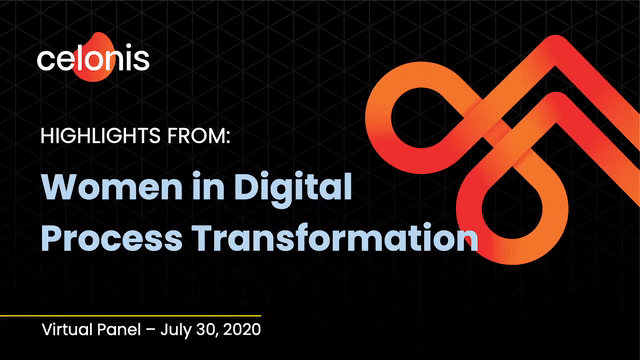
New Technology Needs New Leaders: 5 Powerful Women Sound Off on Digital Transformation
Today, the need for organizations to embrace change and proactively manage transformation has never been higher. With the acceleration of change, digital competition, and increasing customer expectations, it’s more important than ever to leverage emerging technologies from AI and Machine Learning to intelligent automation and Process Mining. “New tools need new rules. To establish these rules, you need strong leadership that ultimately leads this change,” says Hala Zeine, CPO of Celonis who kicked off last week’s panel, Women in Digital Process Transformation with leaders from Qualcomm, Ingram Micro, Inc., and Ascend Performance Materials.

Successful leaders know not just how to use the right solutions, but how to build upward mobility, gain a seat at the table, measure success, and perfect the customer journey. Though women make up more than half of the world’s population, they account for just 17% of the technology workforce and only 5% of enterprise technology leadership. Last week, five influential women leaders came together virtually for a deep dive discussion on how to navigate the professional landscape and champion change.

Though their backgrounds and day-to-day vary widely, the group uncovered common themes on how to advocate change from being resilient and learning from failure to finding allies and leading with purpose. Here’s what they said:
Humanize change
Tipping the scale and propelling lasting change starts with the human aspect. Change is multi-dimensional and requires both intellectual and emotional buy-in to be successful. While technology and tools provide the intellectual proof points for change - we also need to humanize change to make it sustainable. Here’s how:
Be resilient There are several human aspects of work and digital transformation we can bring together to be successful. “Change is hard and will not make you popular all the time, so you must have resilience,” says Jessica Hill Johnson, Senior Director of Finance at Qualcomm. As a leader, it’s imperative to not take things personally: “you’ve got to recover, learn, and move on,” she says.
Create a safe environment People like certainty. The assumption is that change creates instability and risk, so to prepare for this, we must create a safe environment. “You have to create psychological safety and reduce that emotional labor of transformation,” says Sheri Hinish, SupplyChainQueen®, Executive Advisor, and Change Leader. This starts with your team and expands to all stakeholders who will be impacted. By engaging and empowering others, they will be more receptive to giving feedback - up, down, and across.
Find your allies To successfully navigate change within an organization, there is no better time to create allies. By talking to your people, “you find out who are your change agents, who are with you, and who are the detractors,” says Debbie Keehn, SVP and Chief Supply Chain Officer at Ascend Performance Materials. Zeine was careful to point out allies are not necessarily friends but those who have a shared interest, so “recognize your circle of influence and control.”
Obsess with the “why" When it comes to your stakeholders, “managing the real feelings tied to the change can be critical especially with old school thinkers,” says Hinish. “Active listening - seeking to understand and addressing those gaps” is essential to success. “I like those people resistant to change. They tell me everything I should watch out for in the most aggressive way,” Zeine says. She recounts a time early in her career when she changed a manual process: instead of calling up customers in German, writing out their details, and faxing a paper form to another department, she built a fillable online form they could submit, and she would efax. When a more senior stakeholder resisted this, she realized, “He felt less important. He was no longer involved in the process.” So Zeine made a point to mail him a print out - until he agreed using new tools was better and faster. She didn’t ignore his resistance, but made time to understand it.
Turn setbacks into your greatest lessons Failing is never easy, but when you study what went wrong and learn from it you make better choices moving forward. Going too fast can be one of them. “I had some epic failures, and it really was because I wasn’t patient, I didn’t pay attention to stakeholders, and I went too fast and thought everyone would catch up. But learning from failure has allowed me to get to the next level,” says Johnson. Humility attracts and inspires others and ultimately brings people together toward a common goal. So, don’t be afraid to admit when and what went wrong - then keep moving.

Key traits of a successful leader
Women have a different edge in the workplace, and it’s important to discover ways to elevate oneself as a woman and an individual to achieve career success.
Here’s how:
Lead with purpose Successful leaders align their own personal values with their definition of success, and achieve a sense of meaning. It’s important to “clearly define the why and have the right decision architecture,” says Hinish. When you are strategic and create a clear framework, it’s easier to create ongoing motivation toward a goal.
Practice courage When it comes to change, practicing courage is key. “Stakeholders don’t necessarily make the decision, they are influenced by it. But the actual decision taking is within the responsibility of you as a leader. So, you have to have the courage to make these calls,” says Zeine.
Stay authentic and see vulnerability as a strength “Stay true to yourself, but also make sure you are claiming your success,” says Jana Vondran, SVP, Global Business Services at Ingram Micro, Inc. You can be flexible without losing sight of what matters most. It’s impossible to win everyone over, and “some people may have a problem with you. I wouldn’t get in the habit of trying to tailor who you are,” says Hinish. As projects and priorities shift, it’s important to pay attention and be flexible. “Just because I made a decision based on facts six months ago doesn’t mean it’s the right path now. You have to be vulnerable and open to course correct - especially in this agile world we live in,” says Vondron.
Strike a balance between dominance and influence “As a woman you may be seeing things your male colleagues are not. Take someone aside and build that relationship,” says Vondran. This often means finding the right balance between influencing and dominating and can be what makes or breaks keeping momentum with change. To keep people on track in meetings, for example, stick to an agenda, follow up with action items, and make sure you have a facilitator and note taker. “Meeting notes and calls to action are huge, because once it’s in writing - it’s an amazing thing with people - it really helps drive results,” says Johnson. Then you have the disruptive people. “I used to tell those individuals who just want to talk to hear themselves to be quiet. Now I’m a little more subtle and say ‘let’s take this conversation off-line,’” she says. You have to know when to exert influence and when to shut it down. Balancing the two levers as a leader is key. “There are certain things you can control. There are certain things you can influence, and there are things you can’t,” says Johnson. Know the difference and keep going.
Never underestimate the power of communication Transparency with your stakeholders is critical. This is where “you’re derisking the change, learning from things, and preparing the idea for scale,” says Hinish. You can’t get there without impeccable communication. “Sometimes, I communicate to the leaders up here and think they’ll do their communication downwards. Never works. Keep everyone in the loop and be very conscious about messaging,” says Vondran.

When it works, you know
It’s hard to see clear signs of when a process change or digital transformation is successful. It’s difficult to read people - especially over conference calls in our current work landscape. The good news? When it works, you know: “You can just see it - in the process, in the people, and in the results,” says Keehn.
The panel was the first of many opportunities to learn from women leading the way in digital transformation as we continue to build a stronger, more diverse community. Look for upcoming events for Women in Digital Process Transformation, check out Hala’s recent blog about gender equality and changing the narrative, and watch the full panel session here.






